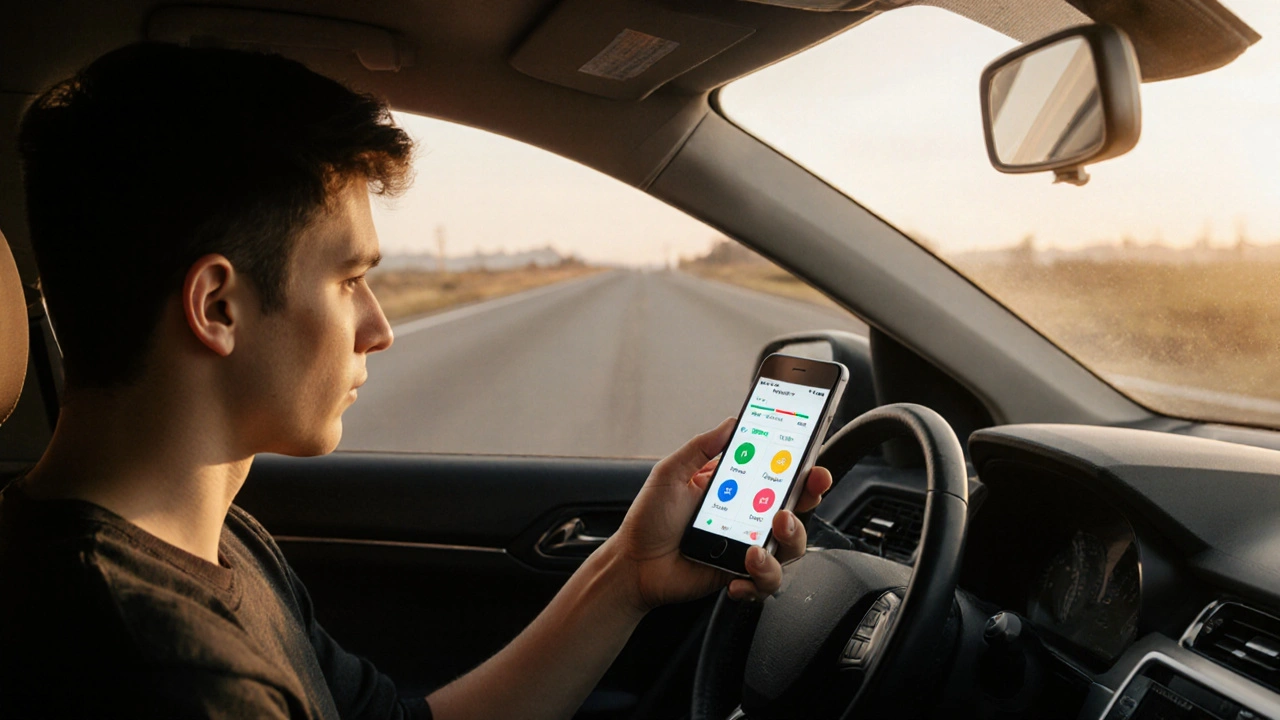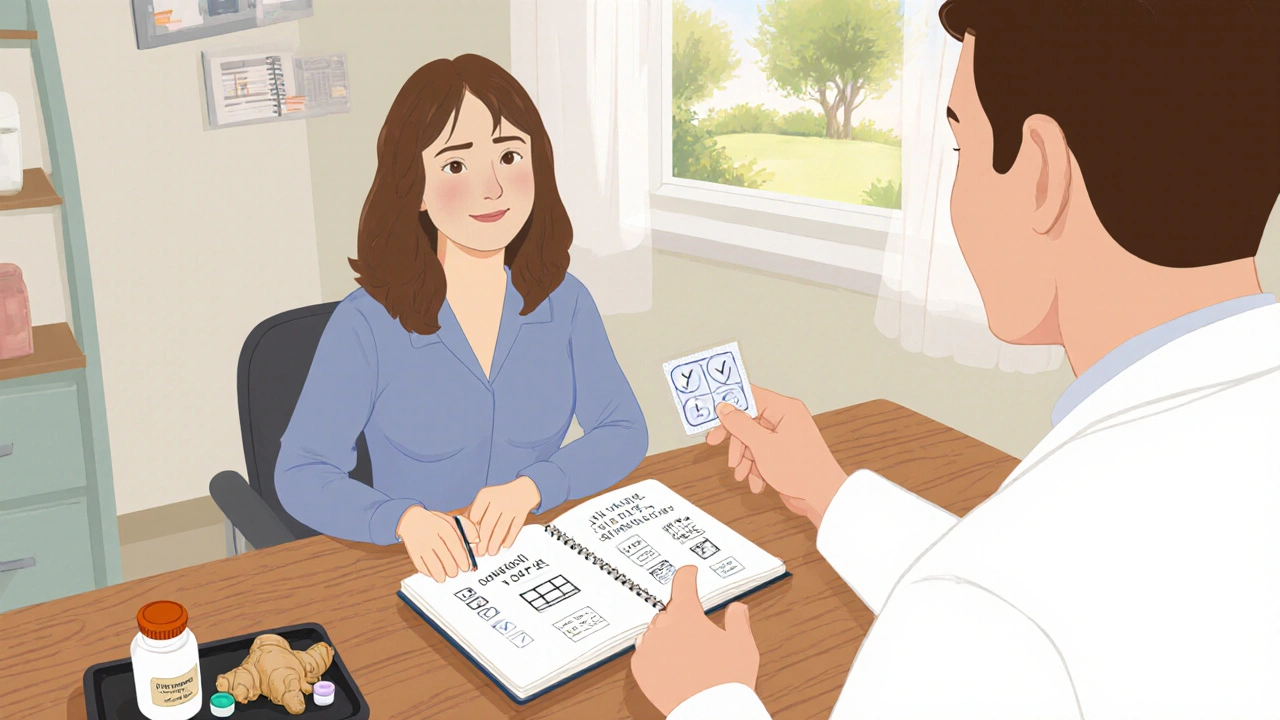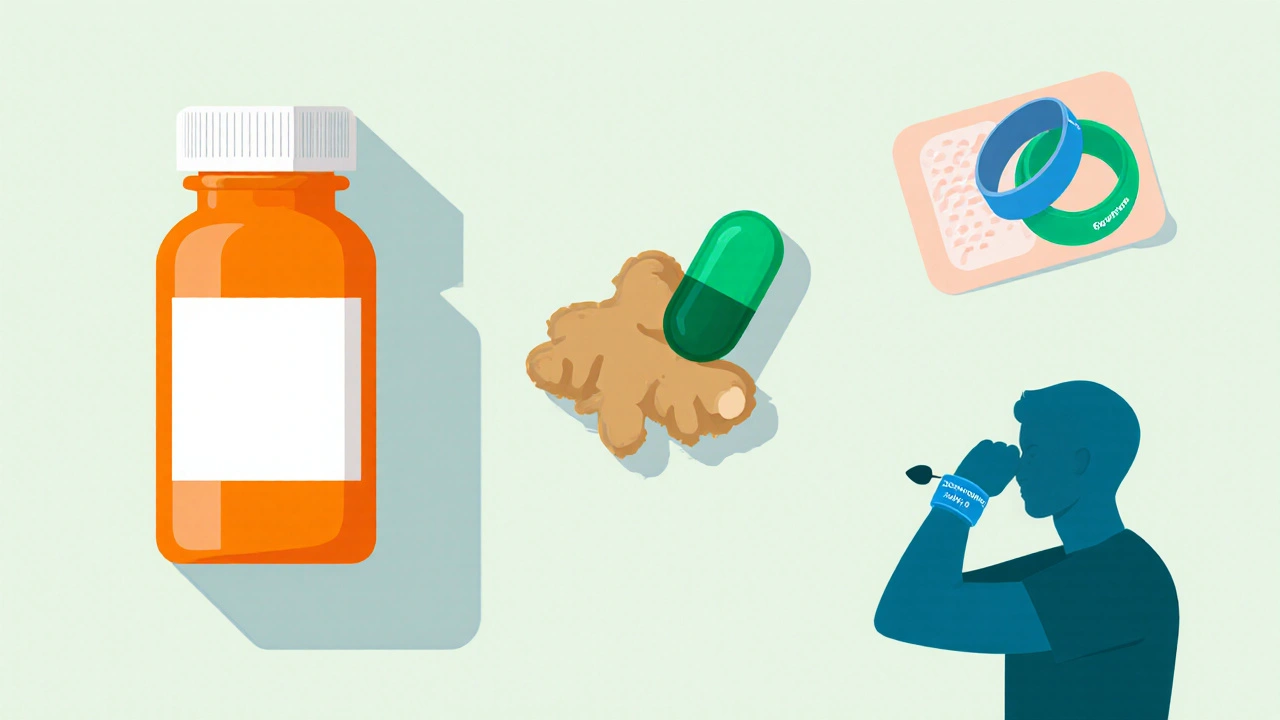Talking to Your Doctor About Motion Sickness: Practical Tips & Questions

Motion Sickness Symptom Tracker
Your Symptom Analysis
Recommended Questions for Your Doctor:
Quick Take
- Write down when symptoms start, how long they last, and what makes them worse.
- Bring a list of any over‑the‑counter remedies you’ve tried.
- Ask about both medication and non‑drug options (e.g., ginger, acupressure).
- Clarify side‑effects, dosing schedule, and when to call back.
- Confirm follow‑up plan before you leave the office.
When you sit down with your clinician, you want the conversation to be clear, focused, and productive. Below is a step‑by‑step guide that walks you through what to prepare, what to ask, and how to understand the treatment options you’ll be offered.
Motion sickness is a disorder of the vestibular system that causes nausea, dizziness, and vomiting during travel or movement. It affects millions of people each year, especially during car trips, flights, or amusement‑park rides. While it’s often brushed off as “just a tummy ache,” chronic or severe episodes can interfere with work trips, vacations, and even daily commutes.
Because the symptoms can mimic other conditions-like inner‑ear infections or medication side effects-talking to a healthcare professional helps you rule out underlying issues and find a safe, effective plan.
Understanding the Roots of Motion Sickness
To explain your situation, it helps to know what’s happening inside your body. The inner ear’s vestibular system detects motion and balance. When visual cues (what you see) and inner‑ear signals (what you feel) don’t line up-say you’re reading in a moving car-the brain receives conflicting information. This mismatch triggers the nausea center in the brainstem, leading to the classic queasy feeling.
Factors that increase susceptibility include:
- Previous episodes of vertigo or ear infections.
- Genetic predisposition (about 30% of people are “high‑risk”).
- Poor sleep, dehydration, or an empty stomach before travel.
- Strong odors, hot cabin temperatures, or reading while moving.
Knowing these triggers lets you give your doctor a concise picture of when and why you get sick.
Why a Doctor Visit Matters
Many folks self‑treat with ginger candies or over‑the‑counter (antihistamines like dimenhydrinate). Those options work for mild cases, but they can cause drowsiness, dry mouth, or interact with other meds. A clinician can:
- Rule out ear disorders, migraines, or medication‑induced nausea.
- Prescribe stronger antiemetics when needed (e.g., scopolamine patches).
- Offer non‑drug strategies such as behavioral therapy or vestibular rehabilitation.
- Adjust existing prescriptions that might worsen motion sickness.
Getting a professional assessment also puts a record in your chart, useful if you travel for work and need documentation for accommodations.
Preparing for the Appointment
Bring a small notebook or use a notes app on your phone. Capture these details before you go:
- Typical travel situations (car, boat, airplane) and duration.
- Exact symptoms (e.g., “spinning sensation,” “dry heaves”).
- What you’ve already tried - brand names, doses, timing.
- Any other health conditions (e.g., high blood pressure, anxiety).
- Current medications and supplements, including herbal products like ginger.
Having this data ready shortens the visit and signals that you’re an engaged patient.

What to Say: Core Questions to Ask
Feel free to adapt the wording, but covering these topics ensures you leave with a clear plan:
- “What could be causing my motion‑related nausea? Are there any underlying conditions I should test for?”
- “Which medication options are safest given my health history?”
- “How do I use a scopolamine patch correctly, and what side‑effects should I watch for?”
- “Are there non‑drug alternatives-like acupressure bands or vestibular exercises-that might help?”
- “If I experience severe vomiting, when should I seek emergency care?”
Ask for written instructions or a patient handout; many offices can print a one‑page summary.
Treatment Landscape: Meds, Natural Aids, and Lifestyle Tweaks
Below is a quick comparison of the most common options. The table focuses on effectiveness, typical dosing, and key side‑effects.
| Option | How It Works | Typical Dose | Effectiveness | Common Side‑effects |
|---|---|---|---|---|
| Dimenhydrinate (Dramamine) | Antihistamine that dampens vestibular signals | 50mg oral 30min before travel | Moderate (60‑70% relief) | Drowsiness, dry mouth |
| Meclizine (Bonine) | Long‑acting antihistamine | 25mg oral 1hour before travel | Moderate‑high (70‑80% relief) | Mild sedation, blurred vision |
| Scopolamine Patch | Anticholinergic that blocks vestibular transmission | 1mg patch behind ear 4hr before travel (replace every 72hr) | High (80‑90% relief) | Dry eyes, confusion, dizziness |
| Ginger Capsules | Natural anti‑nausea compound (gingerol) | 250mg oral 30min before travel | Low‑moderate (40‑55% relief) | Heartburn, mild mouth irritation |
| Acupressure Wristbands | Pressure on P6 point to modulate nausea pathways | Wear 15min before and during travel | Variable (30‑60% relief) | Skin irritation |
Talk to your doctor about which tier fits your routine. For occasional trips, an over‑the‑counter antihistamine may be enough. If you travel weekly for work, a prescription scopolamine patch often proves most reliable, though you’ll need to discuss eye‑dryness management.
Putting It All Together: A Sample Visit Script
Here’s a realistic dialogue you can adapt:
Patient: "I get a queasy feeling plus occasional dizziness whenever I’m on a two‑hour car ride. I’ve tried Dramamine, but it makes me very sleepy." Doctor: "Have you had any ear problems, migraines, or recent medication changes?" Patient: "No ear issues, but I’m on a low‑dose beta‑blocker for hypertension." Doctor: "Given your meds, a scopolamine patch might be a better fit. I’ll also recommend a vestibular rehab exercise you can do at home." Patient: "What side‑effects should I watch for, and how long before the trip should I apply the patch?" Doctor: "Apply it about four hours before travel, and watch for dry eyes or mild confusion. If those become severe, stop using it and call me."
Having a script reduces anxiety and helps you steer the conversation toward actionable advice.
Follow‑Up & Ongoing Management
After you start a new treatment, schedule a short check‑in (phone or telehealth) within a week. Bring notes on:
- How many trips you’ve taken and symptom severity each time.
- Any side‑effects you noticed.
- Whether you paired the medication with lifestyle tricks (e.g., looking at the horizon, staying hydrated).
If the first option isn’t enough, your doctor may adjust the dose or switch to a different class. Don’t hesitate to ask about combined approaches-sometimes a low‑dose antihistamine plus ginger works better than either alone.
Quick Checklist Before You Leave the Exam Room
- Got a written summary of the medication name, dose, and timing?
- Do you have a list of side‑effects to monitor?
- Is there a clear plan for when to call back or schedule a follow‑up?
- Did the doctor explain how to store and dispose of any patches or pills?
Checking these boxes ensures you won’t forget critical details while on the road.

Frequently Asked Questions
Can I use motion‑sickness meds if I’m pregnant?
Most antihistamines like meclizine are considered low‑risk, but you should always discuss any medication with your OB‑GYN. Ginger is generally safe in moderate amounts.
How long does a scopolamine patch stay effective?
One patch releases medication for up to 72hours. For longer trips you can apply a new patch after the first expires, but avoid overlapping.
Is there a non‑drug way to train my vestibular system?
Yes. Vestibular rehabilitation exercises-like head‑turning while focusing on a stable point-can improve tolerance over weeks. A physical therapist can guide you.
What should I do if my motion‑sickness meds make me too drowsy to drive?
Plan ahead: take the medication at least an hour before you need to drive, or choose a non‑sedating option like meclizine low‑dose. If drowsiness persists, avoid driving and arrange alternative transport.
Can I combine ginger with prescription meds?
Generally yes, ginger does not interact with most antiemetics, but high doses might affect blood‑thinning meds. Let your doctor know the exact amount you plan to take.
Armed with these tips, you’ll feel confident walking into the doctor’s office and walking out with a clear plan to beat motion sickness on your next trip.

8 Comments
This guide is solid and it actually helps you beat motion sickness
i get that the article tries to be helpful but honestly most of this stuff is just common sense you could find on a cheap forum people just repeat the same old ginger trick and the scopolamine patch hype which i think is overblown it's not like you're gonna fix every trip by popping a pill
Thanks for putting together such a thorough rundown, it really covers what I've been struggling with.
I used to dread long road trips because the nausea would hit me out of nowhere.
After I started writing down the exact moment the queasy feeling began, I could actually show my doctor the pattern.
That simple habit made the appointment way more productive.
I also tried the ginger capsules they mention and noticed a subtle but real reduction in the intensity of the nausea.
The biggest game changer for me was the scopolamine patch, but only after I asked my doctor about the dry‑eye side effect.
He gave me a tiny bottle of artificial tears and the patch became tolerable.
I love the suggestion to bring a written list of meds and symptoms; it saved us ten minutes of back‑and‑forth.
One tip I added to my own checklist is to avoid reading while the car is moving, which many people overlook.
I also keep a bottle of water handy because dehydration can make the stomach feel worse.
For those who get dizzy, looking at the horizon or focusing on a fixed point in the distance really grounds the vestibular system.
If you have a beta‑blocker or other blood pressure meds, let your doctor know because some anti‑emetics can interact.
Scheduling a quick telehealth follow‑up after the first week of a new prescription helped me tweak the dosage before it became a hassle.
And don’t forget to ask for a printed summary; I once left the office and realized I couldn’t remember the exact timing for the patch.
Bottom line: preparation, clear communication, and a bit of trial‑and‑error will get you back on the road without the bathroom breaks.
Whilst the proposed regimen aligns with contemporary vestibular pharmacodynamics, one must not obfuscate the ontological distinction between prophylactic antihistaminic intervention and anticholinergic modulation; the latter, exemplified by scopolamine, engages central muscarinic receptors with a pharmacokinetic profile that may precipitate xerophthalmia and cognitive encumbrances, thus necessitating a judicious risk‑benefit calculus prior to clinical implementation
Yo, that’s a solid breakdown. I’ve tried the wristbands on a boat ride and they actually kept the nausea at bay for me. Also, staying hydrated and popping a piece of ginger candy before you hop on can make a big diff. Just remember to give your body a few minutes to adjust before you hit the road.
Bring a one‑page symptom summary to the appointment and ask about patch side‑effects.
It is incumbent upon the author to observe that the phrase “what could be causing my motion‑related nausea?” suffers from a syntactic redundancy; a more precise formulation would be “What is the etiology of my motion‑induced nausea?” Moreover, the use of “scopolamine patch” should be capitalised as a proper noun when referring to the specific pharmaceutical device.
ever think the sea is just a mirror for our inner turmoil its waves echo the swirl inside your gut and the cabin sway becomes a metaphor for life how we try to steer through the fog of nausea and yet sometimes the only answer is to breathe and let the motion pass